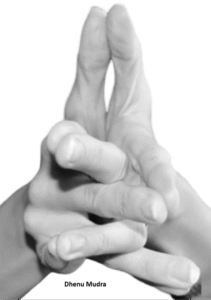Surabhi Mudra
Introduction
Surabhi Mudra, also known as the “Gesture of the Sacred Cow,” is a hand mudra in yoga that promotes physical health, emotional balance, and overall vitality. Traditionally, it is believed to strengthen immunity, improve digestion, and enhance energy flow, while also calming the mind.
The term Surabhi in Sanskrit refers to the sacred cow, a symbol of nourishment, abundance, and vitality. This mudra is often used in yoga therapy to harmonize body energies and enhance overall well-being.
Meaning
Surabhi: Sacred cow, abundance, nourishment.
Mudra: Hand gesture used to direct energy and prana in the body.
Overall Meaning:
Surabhi Mudra symbolizes nourishment, vitality, and stability, creating balance in physical, mental, and emotional energies.
How to Perform / Practice
Sit comfortably in a meditative posture (Padmasana, Sukhasana, or on a chair) with spine erect.
Come into a sitting or kneeling position. Bring the tip of the little finger of your left hand to touch the right ring finger, and the little finger of your right hand to touch the left ring finger. Then join the middle fingers of each hand with the index fingers of the other hand. Extend your thumbs and bring the ends together.
Close your eyes, breathe evenly, and focus on energy flow, nourishment, and balance.
Practice for 15–30 minutes daily, or 5–10 minutes in shorter intervals.
Tip: Best practiced on an empty stomach or after light meals.
Benefits
Physical Benefits:
Supports digestion and metabolism.
Enhances immunity and vitality.
Reduces fatigue and strengthens the body.
Improves circulation and oxygenation.
Mental & Emotional Benefits:
Stabilizes emotions and reduces stress or anxiety.
Improves mental clarity and focus.
Enhances a sense of inner peace and contentment.
Energetic / Spiritual Benefits:
Balances pranic energy in the body.
Supports meditation and mindfulness practices.
Promotes a sense of abundance and harmony.
Contraindications
Avoid if there is recent injury, arthritis, or pain in fingers or hands.
Discontinue if numbness, tingling, or discomfort occurs.
Practice gently without forcing finger positions.
Anatomy & Physiology
Muscles: Intrinsic hand muscles (lumbricals, interossei) and forearm muscles maintain finger positions.
Joints: Flexion at middle and little fingers; extension at index and ring fingers.
Nervous System: Activates parasympathetic system, reducing stress and promoting relaxation.
Circulation: Enhances microcirculation in hands and fingers.
Kinesiology
Improves fine motor control of the fingers.
Enhances neuromuscular coordination between hand and brain.
Supports static postural stability during meditation.
Neurology
Stimulates brain regions associated with focus, calmness, and emotional regulation.
Activates parasympathetic pathways, promoting relaxation and stress reduction.
Supports neural plasticity related to focus, balance, and emotional resilience.
Duration of Practice
Daily Practice: 15–30 minutes, can be split into multiple sessions.
Short Practice: 5–10 minutes during work breaks or meditation.
Can be combined with pranayama or other mudras for enhanced benefits.
Counter Mudra
If excess tension or rigidity develops, alternate with Gyan Mudra or Chala Mudra.
Gentle hand stretching or shaking is recommended after prolonged practice.
Conclusion
Surabhi Mudra is a gentle but effective gesture to enhance vitality, emotional stability, and physical well-being. Regular practice harmonizes the body, mind, and energy systems, making it a valuable tool for yoga therapy, meditation, and daily wellness. Proper and consistent practice ensures maximum benefits without discomfort.
FAQ
Q1: Can beginners practice Surabhi Mudra?
A: Yes, it is safe and simple; start with 5–10 minutes and gradually increase.
Q2: Can it help with digestion and immunity?
A: Yes, it is traditionally used to support digestive function and enhance vitality.
Q3: Can it be combined with other mudras?
A: Yes, it is often combined with Sukam Mudra or Dhyana Mudra during meditation.
Q4: Can it be practiced while walking?
A: Not recommended; best practiced seated to maintain stability and focus.
References
Swami Satyananda Saraswati, Mudras for Healing and Transformation.
Iyengar, B.K.S., Light on Yoga.
Saraswati, S., Pranayama and Mudras in Yoga Therapy.
Fishman, L., Yoga for Emotional Balance.
Journal of Bodywork and Movement Therapies, 2018; 22(4): Effects of Hand Mudras on Mental and Physiological Functions.
